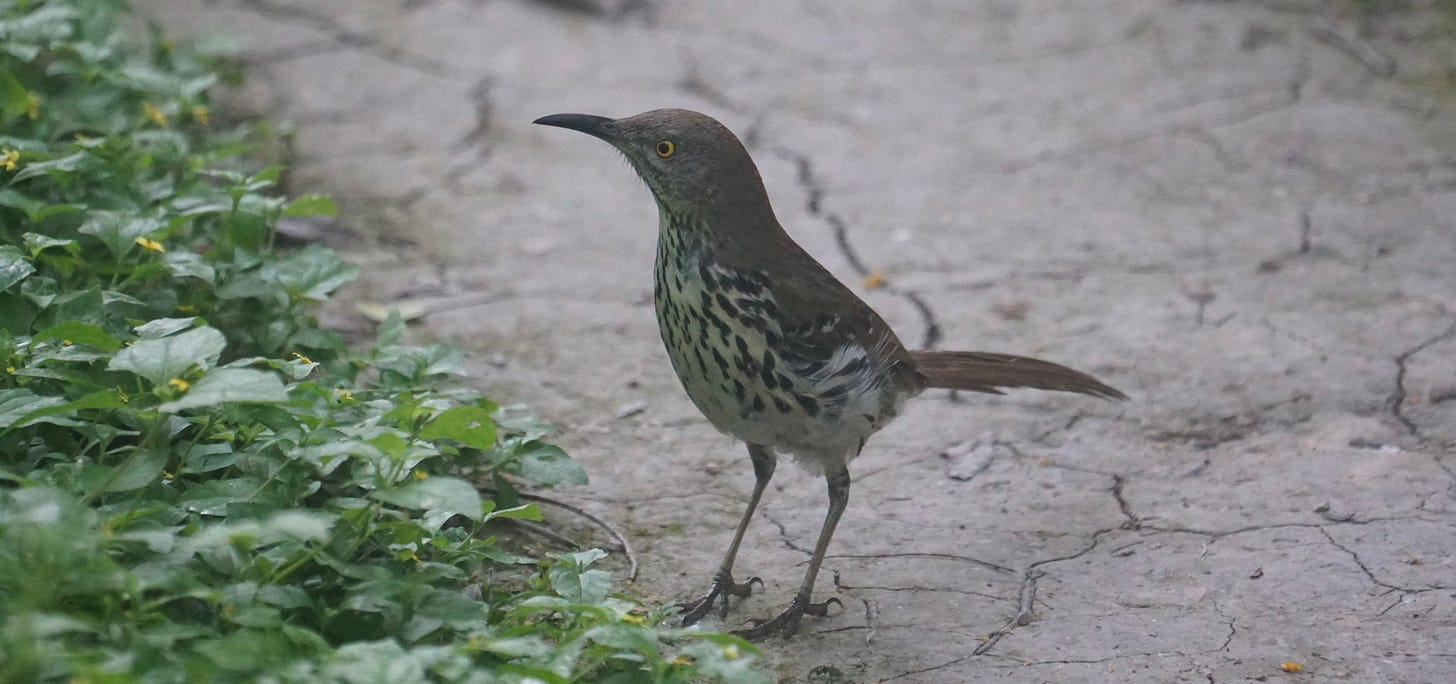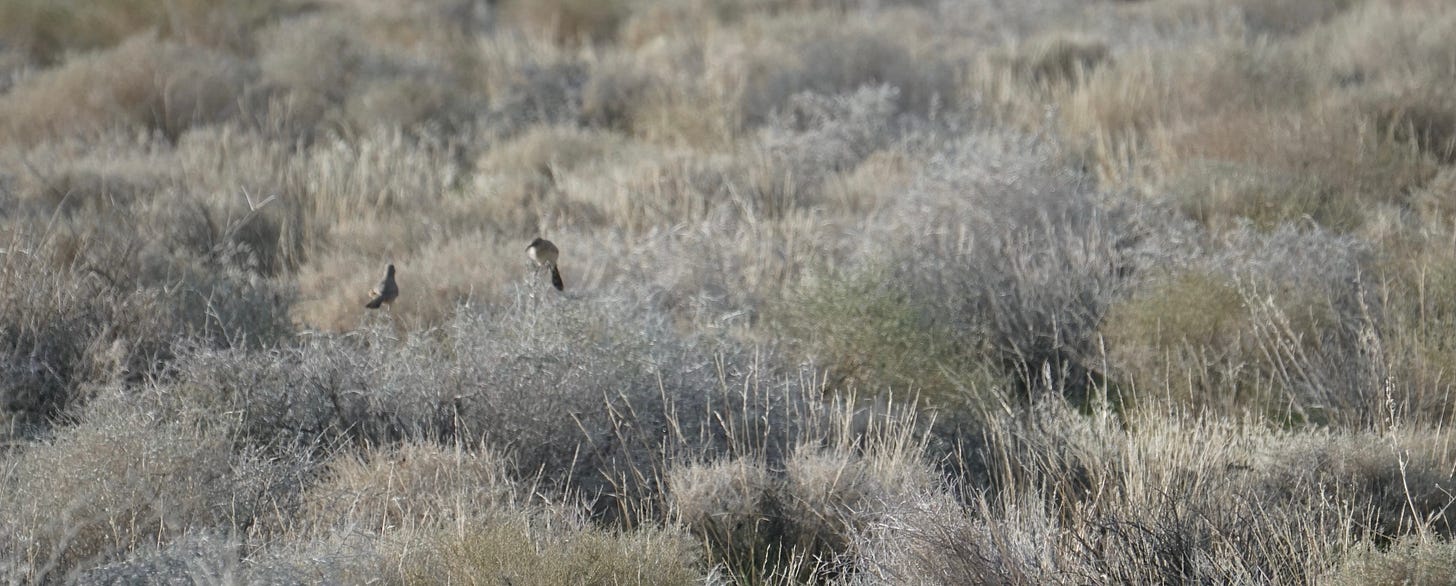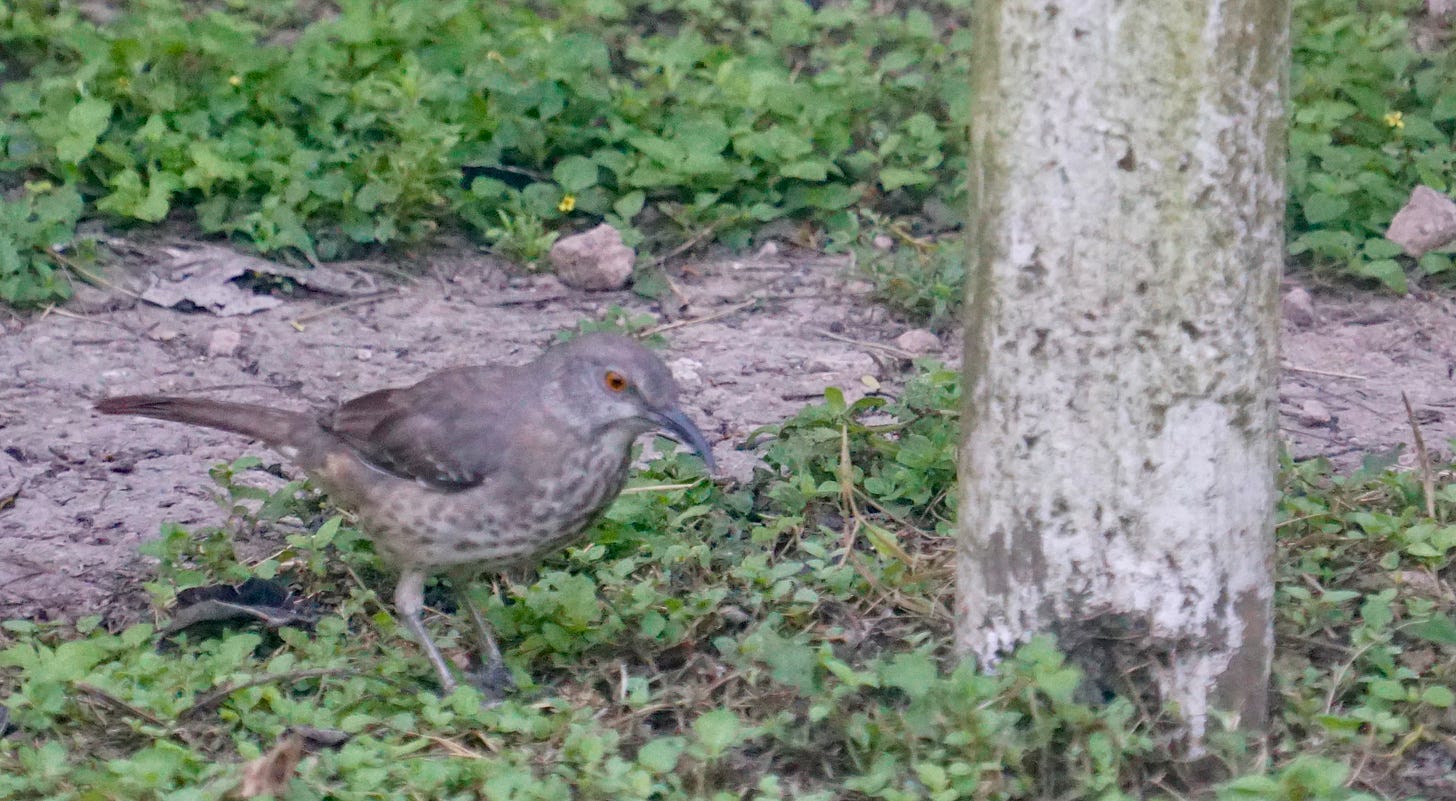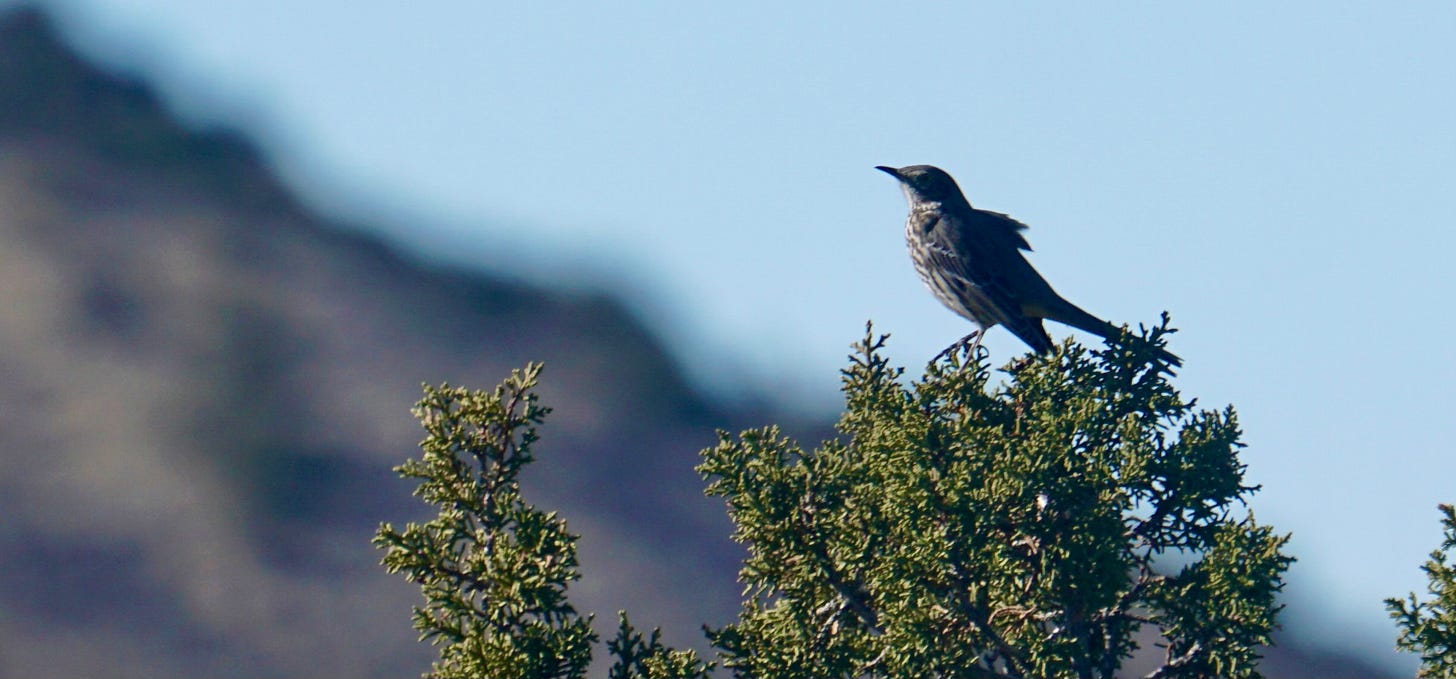Sitting here in Brownsville, Texas, in a cafe window seat with a view to the gray drizzle outside, the mental peacefulness makes it easy to reflect on birds and all of their ineffable qualities. A failed search for a used copy of John Nichols’ Milagro Beanfield War at the lovely Búho Books, and a failed, wet search for a Fan-tailed Warbler on the university campus have landed us here to ruminate. There are few things more inspiring to a desirously artful mind than a hot coffee and warm rain. Though I have known what I wanted to write about for this post for weeks now, life sprinkles concrete thoughts with sparkle-flecks of notions, pulling the brain this way and that. And though this trip has offered a lot of time to stare at nothing and to consider everything, and though we have hours of available time to read and situate ourselves in the universe, for better or for worse, I will stick with the birds for this one.
I have received a lot of great gifts in my life —from my parents, Christmas 1985: Castle Grayskull (He-Man’s rival, Skeletor’s, home and sanctuary of evil); from my sister a few years back: a tabletop Street Fighter pinball game in consolation of the fact that I will most likely never own the full-sized version; from The Ferry, because she is the raddest: a dvd copy of Repo Man; and from our dear friend (also rather rad), Caitlin, this:
Combining 1980’s street-cool with pure avian rock and/or roll, it is easy to see why buying someone a diamond ring is dumb, and why buying them a sticker with a bird on it is not.
Before ending up here at this café, our rainy morning additions of a Clay-colored Sparrow (Spizella pallida), a Black-throated Green Warbler (Setophaga virens) and a flock of Green Parakeets (Psittacara holochlorus), The Ferry and my year list of species observed (never, as always, using playback to call the birds in!) is at 352. That continues to feel like a massive number, considering this is a moderately sized year, and not a big one. Before we hit the arbitrary number of 300 at Falcon State Park a week or so back, we said, arbitrarily: “Whatever number three-hundred is, we will post a spotlight on that bird!” Done and agreed. I always say, irritatingly so, for many people I encounter, “The Ferry and I are those annoying birders who like all birds”, so if number 300 had turned out to be a house sparrow or a sparrow hawk, it would have gotten the same loving word applause that all non-human creatures deserve. That said, what if it happened to be a personal favorite? And, here is where the sticker comes in: Species #300: a badass of the underbrush, the Long-Billed Thrasher (Toxostoma longirostre).

Yes, the sticker shows a Brown Thrasher, not the Long-billed. Yes. So, herein we shall celebrate all of the Thrashers!
Thrashers are New World passerines in the Mimidae family. Mimids are well-renown singers, and thrashers fit perfectly in this family, a group that also includes such vocalese masters as Catbirds and Mockingbirds. As you can imagine, being in such company, the thrashers’ ability for aural agility is pure joy. Rattles and whistles and grunts and pauses and chirps, fluting and fluttering. The Brown Thrasher, alone, is thought to have used over a thousand varied sounds. A thrasher’s range and skill is on par with a 1991 Mariah Carey or an any-year Velvet Fog, Mister Mel Tormé, himself. I might include a late sixties Joe Cocker, but, dear lord, so many moments when old Joey C appeared to edge close to some tremendous emotional tumble, and some physical falls, as well. A thrasher never falls down, vocally or otherwise.
The thrasher genus consists of 14 species, 8 of which live in the US and Canada (only the Brown Thrasher (Toxostoma rufum) can be seen in Canada. Well, and very rarely the Sage Thrasher). Maybe a month before Caitlin gifted me that sticker, The Ferry and I suggested to her that she fly south to San Diego so the three of us could vagabond-about and see if we could get a look at all eight North American thrashers. Sadly, we couldn’t manage that trip. But, joyfully, The Ferry and I have officially seen all of them this year! The Year of the Thrash! This feat, in the bird world, is quite laudable, seeing how any bird poses a modicum of challenge, but thrashers are notoriously skulky, oftentimes remaining low and out of sight, heard and not seen; some of them, Crissal Thrasher (Toxostoma crissale), Bendire’s Thrasher (Toxostoma bendirei) and the giant pain in the ass, Leconte’s Thrasher (Toxostoma lecontei) prefer and enjoy isolated, rather desolate-appearing desert landscapes. A small bird in a sea of arid plains and canyons. It is one of the most sought-after on many a birder’s list. We found the famously challenging Leconte’s outside of the end-of-days “town” of China Lake, California, in a beautifully ignored, and slightly difficult to access place called Short Canyon.

There are certain traits, beyond the relatively secretive nature, that make the thrashers stand out. The majority of these birds fall into the genus Toxostoma (from the Greek, toxon, meaning “arch”, and stoma, meaning “mouth”), so many of them, like the Curve-billed Thrasher below, have uniquely shaped bills used to thresh about in the leaf litter.

The combination of the wicked-witch bill and the all-wise, interplanetary sorcerer is what inspired the 1972 album, Raw Power, by Iggy and the Stooges.
Out of the eight thrashers to be seen in the US—California Thrasher, Crissal Thrasher, Bendire’s Thrasher, Long-billed Thrasher, Curve-billed Thrasher, Leconte’s Thrasher, Brown Thrasher, and the Sage Thrasher—the latter had been a particularly elusive find for many a year. Try as we did, many a time, we always came away questioning whether or not this bird actually existed in the world. Like many of its fellow badasses of the underbrush, the Sage prefers very specific habitat. Unlike the Leconte’s, it does occasionally show up in smaller city parks, relatively populated locations (relatively) or more easily accessed places, but as the name belies, to find it usually means dropping yourself into an old western novella. After having our plans changed by a busted rear differential, we decided to forgo a mountain drive and instead head out to a heavily desert-scrubbed open-space outside of Albuquerque. There, like Hamlet’s father’s ghost, did it appear atop a juniper. Real or imagined? Real, and divine.

Not all thrashers are hard to spot. In Southern California, a day birding without finding a California Thrasher (Toxostoma redivivum) is hard to imagine. They sing from the Sumac and noisily wreck understory shop below the California Sage and the Coyote Brush. Thusly called “thrashers”, much like our beloved thrushes, they scratch among the leaf litter searching for insects, seeds, lizards.
If I were pressed to say what I find most compelling about these birds, it would be hard not to immediately issue yet another pompous look-how-interesting-I-am rock ‘n roll reference; really, though, part of what makes these birds so incredible, for me, is that in watching them we can see how nature and evolution has attempted a balance. Every single creature on this planet, from the massive kilometer-wide Honey Fungus (Armillaria) to the tiniest of bacteria, would actively like to take over the world. Most creatures, however, despite often showing a level of intelligence incomprehensible to human society, do so through instinct and an innate desire to survive; we the Homo not-so-sapiens are really the only species that consciously tries to take over out of pure selfishness and stupidity. So said Kurt Vonnegut: “The good Earth - we could have saved it, but we were too damn cheap and lazy.”
Observing birds, really watching them, clues the observer in on how this whole thing is supposed to work. Thrashers don’t wait on branches, sallying out to snatch a passing fly; they don’t peruse the tree trunks and upper foliage searching for larvae; they don’t soar high above an open field watching and waiting. Thrashers have evolved, as have all birds, to survive through specializing. If all and everyone were to thrash around under the creosote, then competition would assure death by starvation for everyone. If we, as humans, could do as the thrashers, evolve to understand our particular piece in the grand puzzle, then maybe we could get out of this somewhat unscathed. Maybe. But until that day comes: all hail the mighty thrasher!!!







„It’s easy to see why buying someone a diamond ring is dumb and giving them a sticker with a bird on it is not“ 🐦⬛
I Love this T 🖤🪶